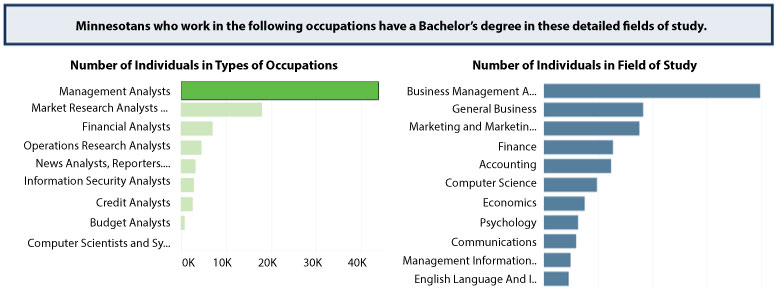View: BDCD Tool Home | User's Guide | Technical Notes | Examples | LMI Help
A much anticipated data tool, a DEED project funded by a 2015 State Longitudinal Data System (SLDS) grant from the U.S. Department of Education, is now available online. Titled “ Bachelor’s Degree and Career Destination” (BDCD), it comprises of an empirical mapping of postsecondary fields of study to occupational outcomes.
This data tool contributes to our understanding of the outcomes of higher education by using empirical-based evidence to map individuals’ undergraduate fields of study to their actual job. Based on Minnesota data of the American Community Survey, this data tool is designed for anyone interested in exploring observed patterns of occupational outcomes by undergraduate field of study.
The Bachelor’s Degree and Career Destination (BDCD) is a visual display of fields of study at the Bachelor’s level and observed labor market outcomes for Minnesota residents. Specifically, the BDCD provides information on occupations, employment, and unemployment, labor force participation, and wage and salary incomes associated with field of study for Bachelor’s degree holders.
The data tool comprises a two-way display that answers the dual questions:
“What occupations do undergraduate degree holders enter?”
To answer this question, the data tool allows users to search and select fields of study from a menu of general or detailed fields of study. Upon selecting a field of study, the tool will show the percentage frequency distribution of occupations held by undergraduate degree holders who majored in the selected field of study. The data are available for the prime working age adults 25 – 64 years who are currently employed, or it can be further broken down by ten year age intervals (25-34; 35-44; 45-54; 55-64).
“What majors do incumbents of occupations come from?”
To answer this question, the data tool allows users to search and select general or detailed occupations from a menu. Upon selecting an occupation, the tool will show the sorted percentage frequency distribution of incumbents by field of degree. The data are available for prime working age adults in ten year age intervals.
Workforce alignment issues: One of the critical challenges of the labor market is to align the supply and demand of skilled workers in order to ensure smooth and efficient fulfillment of job vacancies. In addition, reliable data help postsecondary attendees make informed choices about their fields of study and future career paths. For example, according to DEED employment projections, Minnesota will witness a 42,029 or 11% increase in the number of available Registered Nurses job openings between 2016 and 2026. Given this massive projected increase in the demand for RNs, it is critical to determine if institutions of higher education have the capacity to educate a sufficient number of graduates who are qualified to fill the RN openings.
Empirical approach: Traditional crosswalks have been based in theoretical approaches, that is, where graduates of certain fields of study are likely to be employed. This new data tool summarizes actual occupations for people with a Bachelor’s degree, excluding those with advanced degrees.
Advantage of age breakdown: The BDCD shows the progression of occupational pathways and associated median earnings and other labor force outcomes by age. The underlying premise for the age breakdown is that occupational choices are not necessarily set for life and depending on the field of study, occupational pathways may likely change over time.
Advantage of percentage frequency distribution: The key statistical feature of the BDCD tool is that it shows the percentage frequency distribution of occupation for each field of study. A separate tab, titled “Search by Occupation”, demonstrates the reverse, the distribution of fields of study by occupation. This allows the user to gain an understanding of the relative importance and likelihood of working in an occupation with a specific major, or on the other hand, an understanding of which college majors most occupational incumbents are likely to come from. For example, if an undergraduate student wants to become a management analyst, they will find that about 18% of management analysts hail from the Business Management and Administration field, but a total of about 28% of management analysts are actually from the next four most common fields of study: General Business, Marketing, Finance, and Accounting. Additionally, Computer Science, Economics, Psychology, Communications, and Management Information and Statistics round out the top ten fields of study for management analysts. This allows the end-user to understand that they have some leeway as far as choice of college major is concerned, so that a variety of majors would still leave them with a fairly high likelihood of landing a management analyst position in the job market.
A screenshot using Management Analysts as an example gives a glimpse of the information that this data tool offers.
